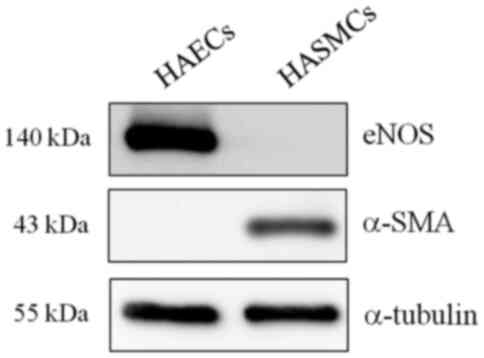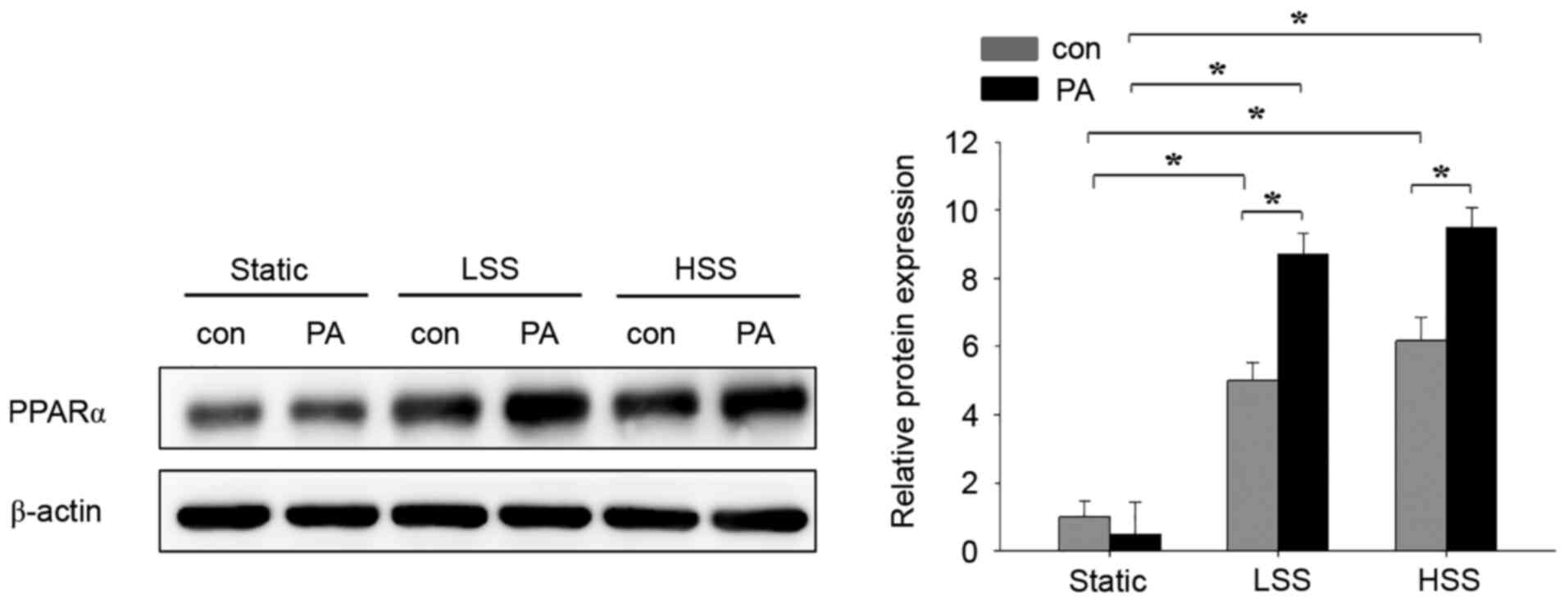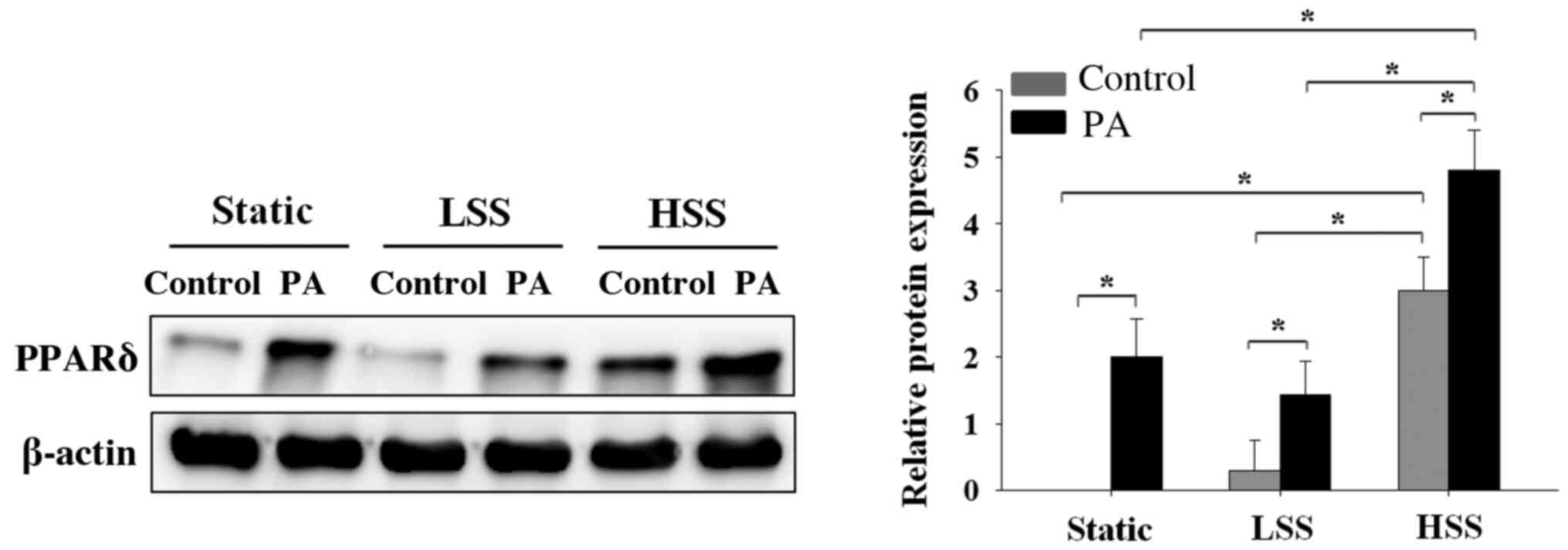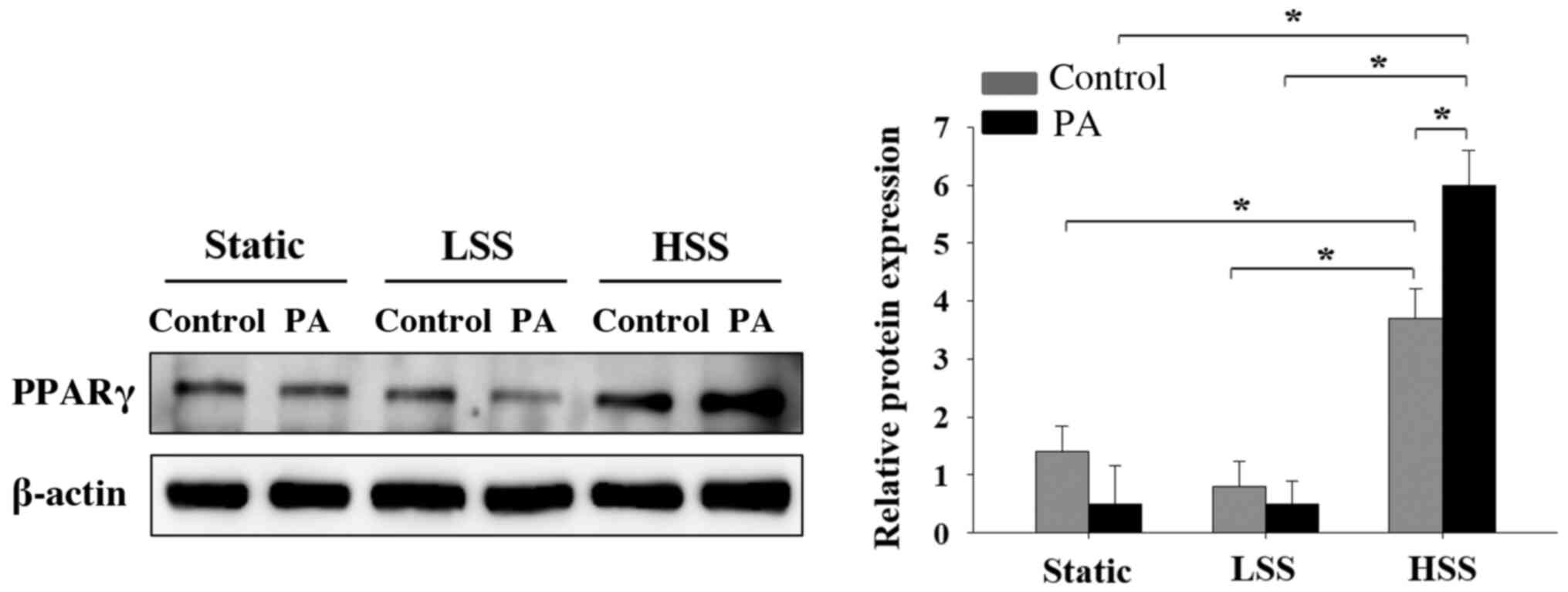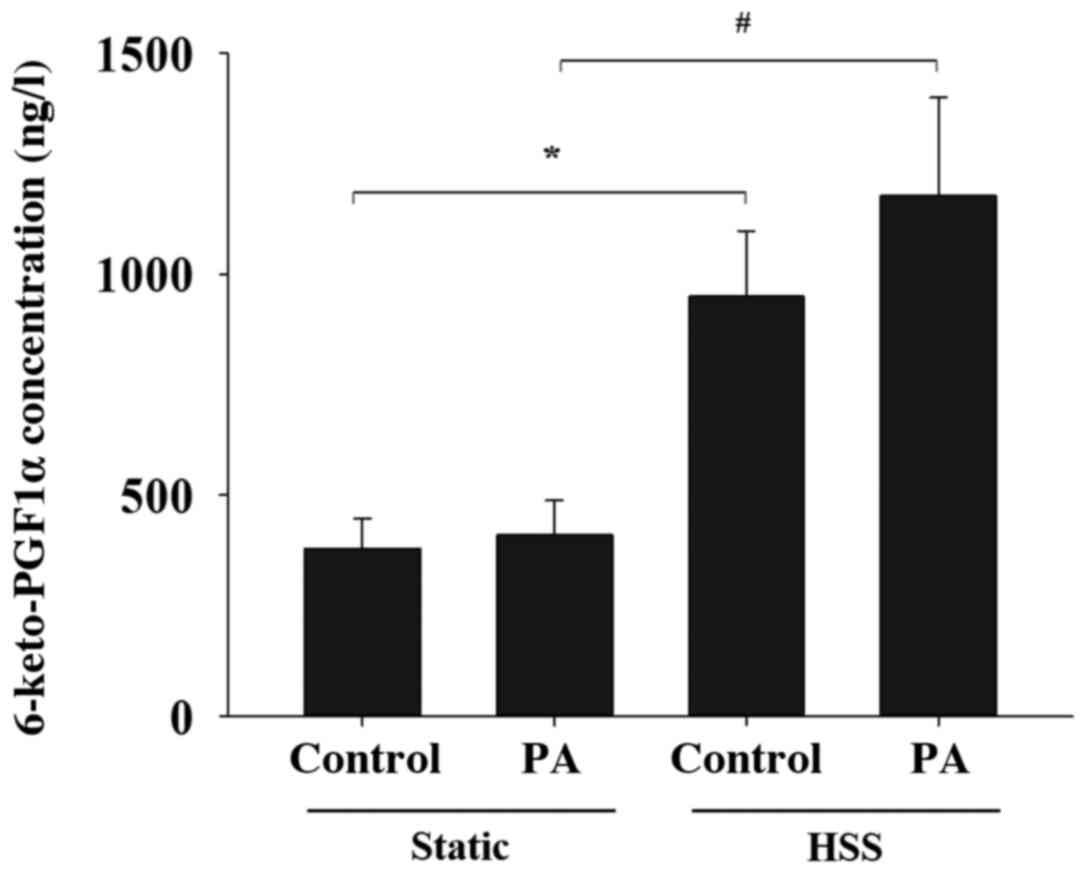|
1
|
Morigi M, Zoja C, Figliuzzi M, Foppolo M,
Micheletti G, Bontempelli M, Saronni M, Remuzzi G and Remuzzi A:
Fluid shear stress modulates surface expression of adhesion
molecules by endothelial cells. Blood. 85:1696–1703.
1995.PubMed/NCBI
|
|
2
|
Surapisitchat J, Hoefen RJ, Pi X,
Yoshizumi M, Yan C and Berk BC: Fluid shear stress inhibits
TNF-alpha activation of JNK but not ERK1/2 or p38 in human
umbilical vein endothelial cells: Inhibitory crosstalk among MAPK
family members. Proc Natl Acad Sci USA. 98:6476–6481.
2001.PubMed/NCBI View Article : Google Scholar
|
|
3
|
Mun GI, An SM, Park H, Jo H and Boo YC:
Laminar shear stress inhibits lipid peroxidation induced by high
glucose plus arachidonic acid in endothelial cells. Am J Physiol
Heart Circ Physiol. 295:H1966–H1973. 2008.PubMed/NCBI View Article : Google Scholar
|
|
4
|
Boden G: Free fatty acids, insulin
resistance, and type 2 diabetes mellitus. Proc Assoc Am Physicians.
111:241–248. 1999.PubMed/NCBI View Article : Google Scholar
|
|
5
|
Liu L, Li Y, Guan C, Li K, Wang C, Feng R
and Sun C: Free fatty acid metabolic profile and biomarkers of
isolated post-challenge diabetes and type 2 diabetes mellitus based
on GC-MS and multivariate statistical analysis. J Chromatogr B
Analyt Technol Biomed Life Sci. 878:2817–2825. 2010.PubMed/NCBI View Article : Google Scholar
|
|
6
|
Yi LZ, He J, Liang YZ, Yuan DL and Chau
FT: Plasma fatty acid metabolic profiling and biomarkers of type 2
diabetes mellitus based on GC/MS and PLS-LDA. FEBS Lett.
580:6837–6845. 2006.PubMed/NCBI View Article : Google Scholar
|
|
7
|
Ghosh A, Gao L, Thakur A, Siu PM and Lai
CWK: Role of free fatty acids in endothelial dysfunction. J Biomed
Sci. 24(50)2017.PubMed/NCBI View Article : Google Scholar
|
|
8
|
Pankow JS, Duncan BB, Schmidt MI,
Ballantyne CM, Couper DJ, Hoogeveen RC and Golden SH:
Atherosclerosis Risk in Communities Study. Fasting plasma free
fatty acids and risk of type 2 diabetes: The atherosclerosis risk
in communities study. Diabetes Care. 27:77–82. 2004.PubMed/NCBI View Article : Google Scholar
|
|
9
|
Inoguchi T, Li P, Umeda F, Yu HY, Kakimoto
M, Imamura M, Aoki T, Etoh T, Hashimoto T, Naruse M, et al: High
glucose level and free fatty acid stimulate reactive oxygen species
production through protein kinase C-dependent activation of NAD(P)H
oxidase in cultured vascular cells. Diabetes. 49:1939–1945.
2000.PubMed/NCBI View Article : Google Scholar
|
|
10
|
Su J, Tian H, Liu R and Liang J:
Inhibitive effects of glucose and free fatty acids on proliferation
of human vascular endothelial cells in vitro. Chin Med J (Engl).
115:1486–1490. 2002.PubMed/NCBI
|
|
11
|
Trombetta A, Togliatto G, Rosso A,
Dentelli P, Olgasi C, Cotogni P and Brizzi MF: Increase of palmitic
acid concentration impairs endothelial progenitor cell and bone
marrow-derived progenitor cell bioavailability: Role of the
STAT5/PPARγ transcriptional complex. Diabetes. 62:1245–1257.
2013.PubMed/NCBI View Article : Google Scholar
|
|
12
|
Song X, Yang B, Qiu F, Jia M and Fu G:
High glucose and free fatty acids induce endothelial progenitor
cell senescence via PGC-1α/SIRT1 signaling pathway. Cell Biol Int.
41:1146–1159. 2017.PubMed/NCBI View Article : Google Scholar
|
|
13
|
Legrand-Poels S, Esser N, L'homme L,
Scheen A, Paquot N and Piette J: Free fatty acids as modulators of
the NLRP3 inflammasome in obesity/type 2 diabetes. Biochem
Pharmacol. 92:131–141. 2014.PubMed/NCBI View Article : Google Scholar
|
|
14
|
Qi Y, Du X, Yao X and Zhao Y: Vildagliptin
inhibits high free fatty acid (FFA)-induced NLRP3 inflammasome
activation in endothelial cells. Artif Cells Nanomed Biotechnol.
47:1067–1074. 2019.PubMed/NCBI View Article : Google Scholar
|
|
15
|
Wang L, Chen Y, Li X and Zhang Y, Gulbins
E and Zhang Y: Enhancement of endothelial permeability by free
fatty acid through lysosomal cathepsin B-mediated Nlrp3
inflammasome activation. Oncotarget. 7:73229–73241. 2016.PubMed/NCBI View Article : Google Scholar
|
|
16
|
Evans RM, Barish GD and Wang YX: PPARs and
the complex journey to obesity. Nat Med. 10:355–361.
2004.PubMed/NCBI View
Article : Google Scholar
|
|
17
|
Chinetti G, Fruchart JC and Staels B:
Peroxisome proliferator-activated receptors (PPARs): Nuclear
receptors at the crossroads between lipid metabolism and
inflammation. Inflamm Res. 49:497–505. 2000.PubMed/NCBI View Article : Google Scholar
|
|
18
|
Marx N, Duez H, Fruchart JC and Staels B:
Peroxisome proliferator-activated receptors and atherogenesis:
Regulators of gene expression in vascular cells. Circ Res.
94:1168–1178. 2004.PubMed/NCBI View Article : Google Scholar
|
|
19
|
Tsai MC, Chen L, Zhou J, Tang Z, Hsu TF,
Wang Y, Shih YT, Peng HH, Wang N, Guan Y, et al: Shear stress
induces synthetic-to-contractile phenotypic modulation in smooth
muscle cells via peroxisome proliferator-activated receptor
alpha/delta activations by prostacyclin released by sheared
endothelial cells. Circ Res. 105:471–480. 2009.PubMed/NCBI View Article : Google Scholar
|
|
20
|
Liu Y, Zhu Y, Rannou F, Lee TS, Formentin
K, Zeng L, Yuan X, Wang N, Chien S, Forman BM and Shyy JY: Laminar
flow activates peroxisome proliferator-activated receptor-gamma in
vascular endothelial cells. Circulation. 110:1128–1133.
2004.PubMed/NCBI View Article : Google Scholar
|
|
21
|
Ge X, Pan P, Jing J, Hu X, Chen L, Qiu X,
Ma R, Jueraitetibaike K, Huang X and Yao B: Rosiglitazone
ameliorates palmitic acid-induced cytotoxicity in TM4 Sertoli
cells. Reprod Biol Endocrinol. 16(98)2018.PubMed/NCBI View Article : Google Scholar
|
|
22
|
Zhang Z, Xie X, Yao Q, Liu J, Tian Y, Yang
C, Xiao L and Wang N: PPARδ agonist prevents endothelial
dysfunction via induction of dihydrofolate reductase gene and
activation of tetrahydrobiopterin salvage pathway. Br J Pharmacol.
176:2945–2961. 2019.PubMed/NCBI View Article : Google Scholar
|
|
23
|
Chiu JJ, Lee PL, Chen CN, Lee CI, Chang
SF, Chen LJ, Lien SC, Ko YC, Usami S and Chien S: Shear stress
increases ICAM-1 and decreases VCAM-1 and E-selectin expressions
induced by tumor necrosis factor-(alpha) in endothelial cells.
Arterioscler Thromb Vasc Biol. 24:73–79. 2004.PubMed/NCBI View Article : Google Scholar
|
|
24
|
Chiu JJ, Chen LJ, Chang SF, Lee PL, Lee
CI, Tsai MC, Lee DY, Hsieh HP, Usami S and Chien S: Shear stress
inhibits smooth muscle cell-induced inflammatory gene expression in
endothelial cells: Role of NF-kappaB. Arterioscler Thromb Vasc
Biol. 25:963–969. 2005.PubMed/NCBI View Article : Google Scholar
|
|
25
|
Chiu JJ, Chen LJ, Lee CI, Lee PL, Lee DY,
Tsai MC, Lin CW, Usami S and Chien S: Mechanisms of induction of
endothelial cell E-selectin expression by smooth muscle cells and
its inhibition by shear stress. Blood. 110:519–528. 2007.PubMed/NCBI View Article : Google Scholar
|
|
26
|
Chang SF, Chang CA, Lee DY, Lee PL, Yeh
YM, Yeh CR, Cheng CK, Chien S and Chiu JJ: Tumor cell cycle arrest
induced by shear stress: Roles of integrins and Smad. Proc Natl
Acad Sci USA. 105:3927–3932. 2008.PubMed/NCBI View Article : Google Scholar
|
|
27
|
Chiu JJ and Chien S: Effects of disturbed
flow on vascular endothelium: Pathophysiological basis and clinical
perspectives. Physiol Rev. 91:327–387. 2011.PubMed/NCBI View Article : Google Scholar
|
|
28
|
Vessby B: Dietary fat, fatty acid
composition in plasma and the metabolic syndrome. Curr Opin
Lipidol. 14:15–19. 2003.PubMed/NCBI View Article : Google Scholar
|
|
29
|
Guerci B, Böhme P, Kearney-Schwartz A,
Zannad F and Drouin P: Endothelial dysfunction and type 2 diabetes.
Part 2: Altered endothelial function and the effects of treatments
in type 2 diabetes mellitus. Diabetes Metab. 4:436–447.
2001.PubMed/NCBI
|
|
30
|
Ndisang JF: Cross-talk between heme
oxygenase and peroxisome proliferator-activated receptors in the
regulation of physiological functions. Front Biosci (Landmark Ed).
19:916–935. 2014.PubMed/NCBI View
Article : Google Scholar
|
|
31
|
Taba Y, Sasaguri T, Miyagi M, Abumiya T,
Miwa Y, Ikeda T and Mitsumata M: Fluid shear stress induces
lipocalin-type prostaglandin D(2) synthase expression in vascular
endothelial cells. Circ Res. 86:967–973. 2000.PubMed/NCBI View Article : Google Scholar
|
|
32
|
Ye G, Gao H, Wang Z, Lin Y, Liao X, Zhang
H, Chi Y, Zhu H and Dong S: PPARα and PPARγ activation attenuates
total free fatty acid and triglyceride accumulation in macrophages
via the inhibition of Fatp1 expression. Cell Death Dis.
10(39)2019.PubMed/NCBI View Article : Google Scholar
|
|
33
|
Moraes LA, Piqueras L and Bishop-Bailey D:
Peroxisome proliferator-activated receptors and inflammation.
Pharmacol Ther. 110:371–385. 2006.PubMed/NCBI View Article : Google Scholar
|
|
34
|
Doroudi R, Gan LM, Selin Sjögren L and
Jern S: Effects of shear stress on eicosanoid gene expression and
metabolite production in vascular endothelium as studied in a novel
biomechanical perfusion model. Biochem Biophys Res Commun.
269:257–264. 2000.PubMed/NCBI View Article : Google Scholar
|
|
35
|
Frangos JA, Eskin SG, McIntire LV and Ives
CL: Flow effects on prostacyclin production by cultured human
endothelial cells. Science. 227:1477–1479. 1985.PubMed/NCBI View Article : Google Scholar
|
|
36
|
Vane J and Corin RE: Prostacyclin: A
vascular mediator. Eur J Vasc Endovasc Surg. 26:571–578.
2003.PubMed/NCBI View Article : Google Scholar
|
|
37
|
Rolland PH, Jouve R, Pellegrin E, Mercier
C and Serradimigni A: Alteration in prostacyclin and prostaglandin
E2 production. Correlation with changes in human aortic
atherosclerotic disease. Arteriosclerosis. 4:70–78. 1984.PubMed/NCBI View Article : Google Scholar
|
|
38
|
Shimokawa H: Primary endothelial
dysfunction: Atherosclerosis. J Mol Cell Cardiol. 31:23–37.
1999.PubMed/NCBI View Article : Google Scholar
|
|
39
|
Di Francesco L, Totani L, Dovizio M,
Piccoli A, Di Francesco A, Salvatore T, Pandolfi A, Evangelista V,
Dercho RA, Seta F and Patrignani P: Induction of prostacyclin by
steady laminar shear stress suppresses tumor necrosis factor-alpha
biosynthesis via heme oxygenase-1 in human endothelial cells. Circ
Res. 104:506–513. 2009.PubMed/NCBI View Article : Google Scholar
|















